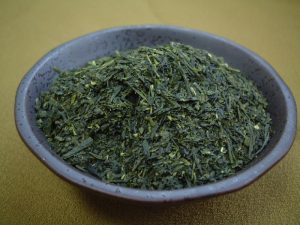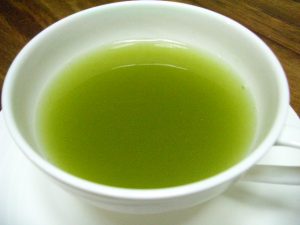 Fukamushicha (深蒸し茶, deep-steamed tea) is a green tea that is initially steamed for a longer time than what it’s considered to be usual. It’s commonly produced in the prefecture of Shizuoka.
Fukamushicha (深蒸し茶, deep-steamed tea) is a green tea that is initially steamed for a longer time than what it’s considered to be usual. It’s commonly produced in the prefecture of Shizuoka.
Normally, the steaming process for green tea runs for about 30 to 40 seconds, and the resulting tea is called futsuumushicha (普通蒸し茶, normal steamed tea).
In contrast, fukamushicha is steamed for a minute or longer.
Another term, although not as common, is asamushicha (浅蒸し茶, light-steamed tea). This tea is steamed for less than 30 seconds.
What tea leaves are used in the fukamushi process?
Leaves from sencha, gyokuro, kabusecha and even bancha can be deep-steamed. When this happens, the name gains the fukamushi prefix, for example fukamushi genmaicha (深蒸し玄米茶).
However, most of the time it’s fukamushi sencha (深蒸し煎茶), and sometimes people say fukamushicha to refer to deep-steamed sencha.
By the way, tea leaves that undergo the kamairi process can’t be steamed, because they are already pan fried.
What are the advantages of deep-steaming?
The steaming process makes a big difference in the flavor of green tea. The main advantages of using the fukamushi process is that the astringency is suppressed, while gaining more body and sweetness.
The longer steaming time makes the leaves very soft, and during the rolling process the tips often break. This small particles make the fukamushicha look like if it was a lower-quality tea, but it really isn’t.
When brewed it also has a darker color, with sediments on the bottom. One would think that it’s a very bitter tea, such as funmatsucha.
The appearance of fukamushicha is a disadvantage, although as a bonus, the small particles means that the health benefits increase. How come? Just as with matcha and funmatsucha, when drinking the small solid particles you’ll get more of the nutrients found in green tea (such as catechins), plus the ones that aren’t water-soluble like fiber, some vitamins, and chlorophyll.
Fukamushicha is also a little harder to brew.
If your infuser has openings that are too wide, the particles won’t be filtered. The infuser should also have a large surface area, because fukamushicha can quickly clog a surface that’s too small.
For this reason, it is recommended to use a kyusu (Japanese teapot) especially designed for brewing fukamushicha.
History of fukamushicha
The fukamushi process became popular in the 1960s, which is quite recent. The starting point, however, is credited to Tozuka Toyozou (戸塚豊蔵) in the Meiji period.
Tozuka developed a rolling process by hand, which he refined and later proposed in a tea industry’s convention.
Until then, most of the green tea in Japan was made from steamed leaves that were dried in the sun. The rolling process greatly enhanced the taste and appearance of the tea.
As a result of those new standards, the variations in steaming time were studied as well. This led to the modern fukamushi process.
How to brew fukamushicha
 Fukamushi sencha is the most common fukamushicha. It’s brewed just like sencha, but with a lower steeping time.
Fukamushi sencha is the most common fukamushicha. It’s brewed just like sencha, but with a lower steeping time.
The general guideline is: 60 to 100 ml (2 to 3.33 oz) per cup, 3 gr (3/4 of a teaspoon), 70 to 80°C (158°F to 176°F), 40 seconds of steeping time.
Bring water to a boil. Then pour the water into the cups that you will serve. Your water will have cooled a bit after pouring.
Now place 3 grams of fukamushi sencha in your teapot. Pour the water from each cup into the teapot and brew for 40 seconds.
Now serve into each cup, little by little and alternating from cup to cup. That way each cup will have the same concentration of tea.





January 28, 2017
Does this tea stand up to multiple brewings well?
Or at all?
January 29, 2017
Hi Jon
Yes, it can re-infused several times. Four times is about the standard.
March 5, 2017
How does a fukamushi shincha differ from fukamushi shencha? I assume that it is milder…
March 5, 2017
Hi Eric
The difference would be in a higher amount of amino acid content. That is, the fukamushi shincha would have more umami taste and sweetness.
March 5, 2017
Thank you Ricardo,
I am experimenting with a fukamushi shincha a friend brought from Japan. I live in California.
I will be trying to experiment with it, and learn more about tastes by carefully appreciating it as I drink it.
Eric
February 15, 2019
Thank you for this post. Very useful.
February 15, 2019
Thank you for reading Sebastien.
September 12, 2019
Just what I needed. Very informatic and well-written article to appreciate the brilliant brew.
Thank you!
September 12, 2019
Hi Krzystof
Good to hear that it was what you needed : )
September 12, 2019
Thank you for replying this fast. I’m really excited to have found such a great website. I’ve already spent a fair amout of time learing more about the types of tea I brought from my trip to Japan. Also forgive my language, but I’m not a native speaker and by „informatic” i meant informative. Keep up the good work!
November 17, 2022
Thanks for all the good information
Any tips for brewing asamushicha? longer steeping time or just like ordinary sencha?
November 18, 2022
Hi Anders
Thank you for your question.
Yes, asamushicha (light steamed tea) should be brewed longer than normal sencha, 1.5 minutes instead of 1.
January 8, 2023
I think its only fair to allow a differing opinion. To me, fukamushicha teas are not that great. Light steamed is the best. Why? Light steamed preserves more of the nutrients and flavor that gets steamed away during the deep steamed process. On top of that, the deep steamed teas introduce some flavor components that distort and spoil the flavor. One such component is the addition of Chlorophyll. This addition, which is almost completely absent in light steamed teas, adds a flavor that is gross. These added flavors do not in my opinion improve the tea; instead they corrupt it, and ruin it. The only decent fukamushicha tea I have tried is Kirishima sencha, and I have tried multiple types. Actually its more of a medium steamed, but pretty much the same. Lightly steamed teas are the best, and most Japanese tea connoisseurs will agree with me. Pure and elegant, they don’t need to be broken down by excess steam, as their flavor speaks for themselves…
January 19, 2023
Just a few more comments about the deep steamed teas. I have heard some say they taste rich. I would disagree. If anything they trade the authentic tea flavor, for other flavors like chlorophyll, which really dominate. Both the rich smell, and proper tea flavors are quite muted in the deep steamed teas. If I want to drink something that tastes like chlorophyll, I will drink juiced wheatgrass or barleygrass. Don’t misunderstand me, I love grassy flavors, but in the deep steamed teas that is largely replaced by a chlorophyll flavor that takes over. I have found even some Gyokuro teas that have been steamed too long, having a similar flavor which ruins it. The light steamed or almost medium steamed teas present the best flavors found in Japanese teas in my opinion.
I have been drinking Japanese green teas for almost 20 years.